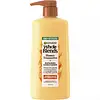What's inside
What's inside
 Key Ingredients
Key Ingredients

 Benefits
Benefits

 Concerns
Concerns

 Ingredients Side-by-side
Ingredients Side-by-side

Water
Skin ConditioningCetearyl Alcohol
EmollientBehentrimonium Chloride
PreservativeAmodimethicone
Honey
HumectantArgania Spinosa Kernel Oil
EmollientPotassium Hydroxide
BufferingRoyal Jelly
Glycerin
HumectantTrideceth-6
EmulsifyingAloe Barbadensis Leaf Juice
Skin ConditioningAlcohol
AntimicrobialPropolis Extract
Skin ConditioningIsopropyl Alcohol
SolventCitric Acid
BufferingPhenoxyethanol
PreservativeCetrimonium Chloride
AntimicrobialBenzoic Acid
MaskingCI 15985
Cosmetic ColorantCI 19140
Cosmetic ColorantParfum
MaskingCoumarin
PerfumingLimonene
PerfumingBenzyl Alcohol
PerfumingBenzyl Salicylate
PerfumingFish Oil
Skin ConditioningCeramide AP
Skin ConditioningWater, Cetearyl Alcohol, Behentrimonium Chloride, Amodimethicone, Honey, Argania Spinosa Kernel Oil, Potassium Hydroxide, Royal Jelly, Glycerin, Trideceth-6, Aloe Barbadensis Leaf Juice, Alcohol, Propolis Extract, Isopropyl Alcohol, Citric Acid, Phenoxyethanol, Cetrimonium Chloride, Benzoic Acid, CI 15985, CI 19140, Parfum, Coumarin, Limonene, Benzyl Alcohol, Benzyl Salicylate, Fish Oil, Ceramide AP
Water
Skin ConditioningCetearyl Alcohol
EmollientStearamidopropyl Dimethylamine
EmulsifyingCocos Nucifera Oil
MaskingHydrolyzed Elastin
EmollientSea Salt
AbrasiveHydrolyzed Keratin
HumectantHydrolyzed Wheat Protein
Skin ConditioningPanthenol
Skin ConditioningTocopheryl Acetate
AntioxidantAscorbic Acid
AntioxidantParfum
MaskingBehentrimonium Chloride
PreservativeLactic Acid
BufferingDipropylene Glycol
HumectantPotassium Chloride
Trehalose
HumectantDisodium EDTA
Gluconolactone
Skin ConditioningDMDM Hydantoin
PreservativeAdipic Acid
BufferingSodium Sulfate
Methylchloroisothiazolinone
PreservativeMethylisothiazolinone
PreservativeWater, Cetearyl Alcohol, Stearamidopropyl Dimethylamine, Cocos Nucifera Oil, Hydrolyzed Elastin, Sea Salt, Hydrolyzed Keratin, Hydrolyzed Wheat Protein, Panthenol, Tocopheryl Acetate, Ascorbic Acid, Parfum, Behentrimonium Chloride, Lactic Acid, Dipropylene Glycol, Potassium Chloride, Trehalose, Disodium EDTA, Gluconolactone, DMDM Hydantoin, Adipic Acid, Sodium Sulfate, Methylchloroisothiazolinone, Methylisothiazolinone
 Reviews
Reviews

Ingredients Explained
These ingredients are found in both products.
Ingredients higher up in an ingredient list are typically present in a larger amount.
This ingredient is a preservative and often used for it's anti-static properties. You'll most likely see this ingredient in hair conditioners.
It does not cause irritation or sensitization in leave-on products at 1-5%.
Cetearyl alcohol is a mixture of two fatty alcohols: cetyl alcohol and stearyl alcohol. It is mainly used as an emulsifier. Emulsifiers help prevent the separation of oils and products. Due to its composition, it can also be used to thicken a product or help create foam.
Cetearyl alcohol is an emollient. Emollients help soothe and hydrate the skin by trapping moisture.
Studies show Cetearyl alcohol is non-toxic and non-irritating. The FDA allows products labeled "alcohol-free" to have fatty alcohols.
This ingredient is usually derived from plant oils such as palm, vegetable, or coconut oils. There is debate on whether this ingredient will cause acne.
Due to the fatty acid base, this ingredient may not be Malassezia folliculitis safe.
Learn more about Cetearyl AlcoholParfum is a catch-all term for an ingredient or more that is used to give a scent to products.
Also called "fragrance", this ingredient can be a blend of hundreds of chemicals or plant oils. This means every product with "fragrance" or "parfum" in the ingredients list is a different mixture.
For instance, Habanolide is a proprietary trade name for a specific aroma chemical. When used as a fragrance ingredient in cosmetics, most aroma chemicals fall under the broad labeling category of “FRAGRANCE” or “PARFUM” according to EU and US regulations.
The term 'parfum' or 'fragrance' is not regulated in many countries. In many cases, it is up to the brand to define this term.
For instance, many brands choose to label themselves as "fragrance-free" because they are not using synthetic fragrances. However, their products may still contain ingredients such as essential oils that are considered a fragrance by INCI standards.
One example is Calendula flower extract. Calendula is an essential oil that still imparts a scent or 'fragrance'.
Depending on the blend, the ingredients in the mixture can cause allergies and sensitivities on the skin. Some ingredients that are known EU allergens include linalool and citronellol.
Parfum can also be used to mask or cover an unpleasant scent.
The bottom line is: not all fragrances/parfum/ingredients are created equally. If you are worried about fragrances, we recommend taking a closer look at an ingredient. And of course, we always recommend speaking with a professional.
Learn more about ParfumWater. It's the most common cosmetic ingredient of all. You'll usually see it at the top of ingredient lists, meaning that it makes up the largest part of the product.
So why is it so popular? Water most often acts as a solvent - this means that it helps dissolve other ingredients into the formulation.
You'll also recognize water as that liquid we all need to stay alive. If you see this, drink a glass of water. Stay hydrated!
Learn more about Water